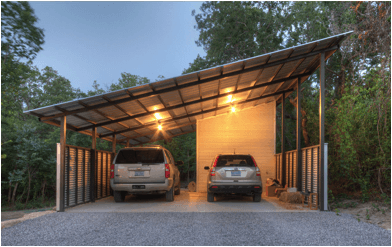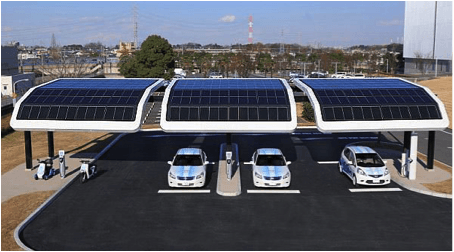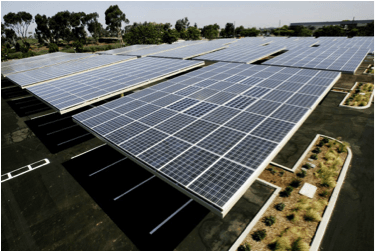A solar carport is a canopy that captures solar energy placed over a parking area. They provide a huge opportunity to use otherwise wasted parking lot space to create renewable energy. While a typical carport or patio cover provides shading and is undoubtedly a value-add for a home or automobile owner, its one-dimensional simplicity is a missed opportunity. If you’re a PV fanatic following emerging technologies in the solar industry, you may have already spotted the solar industry’s solution: solar canopies, also known as solar carports .
Key takeaways about solar carports
- A solar carport is a canopy over one or more parking space with solar panels on it
- Both commercial and residential properties can benefit from carports
- Compare solar quotes for your unique roof setup on the EnergySage Marketplace
What is a solar panel carport?
Solar carports are overhead canopies built to cover parking areas, and are distinct from panels installed onto a preexisting carport structure. Solar carports have many things in common with ground mount solar panels, which are angled panel modules installed on the ground rather than on a rooftop.
Both ground mount solar and solar carports eliminate the need for a surface on which the panels could be mounted. The primary difference between a solar carport and a typical ground mount installation is that carports are taller in order to make space for a car to park. Otherwise, the two are quite similar and each offer the benefit of allowing installers to orient the panels at the most optimal angle for sunlight exposure.
The great advantage of solar carports and solar patio covers is that they don’t require additional land the way ground mount does. As a result, solar panel carports offer a more efficient use of space than ground-mounted panels. Certain states, like Massachusetts, even have incentives for solar canopy structures over ground mount. If you are concerned about efficient use of space, you should consider a solar carport over a ground-mounted system. Overall, solar panel carports have less restraints or conflicts than ground-mounted solar, and can be considered preferable under many circumstances.
Comparing commercial and residential carports
To date, solar carports are much more popular in the U.S. commercial sector than in residential markets. Many businesses have embraced the idea of installing massive solar canopies for parking lots.
When it comes to commercial and residential solar canopies, there are a number of different layouts and sizes available. Dependent on the number of rows of parking required, a photovoltaic carport are typically one, two or three rows wide. Solar parking lots, by comparison, can be large enough to span dozens of rows of parking. Installing a solar canopy can power your home, or it can turn a wide-open stretch of pavement into a major electricity generator.
Other than a solar carport’s size, the main way that solar carport construction varies is in the angle of the panels. The panels will either be angled upwards in one direction (Figure A), angled and curved in one direction leading to a flat surface (Figure B) or very slightly angled to the point of appearing flat (Figure C), typically in order to provide shading and coverage for a larger number of cars.



One reason why residential has an advantage over commercial when it comes to canopies and carports is the materials used for construction. Commercial solar carports will almost always need a steel metal foundation, which adds a significant expense to total installation. By comparison, smaller residential carports have flexibility around structure material and design – a homeowner could choose a larger carport layout or a smaller patio cover to host a modest solar system.
How does a solar carport compare to a rooftop solar panel installation?
As with ground mount solar, it is often assumed that versatile solutions like solar carports and ground mount are only meant for homeowners who did not qualify for rooftop solar panels. However, the reality is that these alternative options can often make more sense for homeowners due a number of factors.
Issues with roof angle, orientation and size are eliminated with a carport because the panels will serve as the “roof” of the structure, and the supporting metal poles can be situated as necessary once the optimal array size and angle is determined. With rooftop solar, homeowners often run into issues installing a big enough system because they may not have suitable roof area. Space constraints are eliminated with ground mount solar and are rare with solar canopies and carports.
In order to compare and contrast the various array types (carport, ground mount, rooftop) for yourself, check out the table below. This table contains average U.S. dollars per watt, system size, most popular solar panel brand and percentage need met (referring to what percentage of electricity needs the array supplied on average) based on data from the EnergySage Solar Marketplace. The table will help to answer possibly the most important question to homeowners curious about solar carports: regardless of how convenient or efficient solar carports are, how do they compare to rooftop solar on bill savings and cost?
Residential solar comparison by mount location
| Measure | Solar Carport | Rooftop Solar | Ground Mount Solar |
|---|---|---|---|
| Dollars per watt | $3.31 | $2.81 | $3.11 |
| Average system size | 12.3 kW | 10.2 kW | 13.0 kW |
| Percentage need met | 98.8% | 95.8% | 95.4% |
| Leading panel brand | REC | Panasonic | Q CELLS |
Source: EnergySage Solar Marketplace quotes for solar systems
There are many insights from the above solar array comparison, but the first clear takeaway is that solar carports are a viable option for homeowners, even when compared to rooftop and ground mount solar. Though the dollars per watt figure from this dataset is slightly higher than ground mount and significantly higher than rooftop PV, the cost of solar carports may fall faster than either of its counterparts over the coming years.
The comparison also shows that there are parallels between solar carport and ground mount solar systems. Both options allow for bigger system sizes than rooftop (likely due to a lack of space constraints), and both are conducive to panels that an average rooftop system also often uses (LG).
How to get your own solar carport installation
Because solar panel carports are still a new and growing product offering in the U.S. solar industry, it may not be obvious as to how to get one for your home. However, the majority of installers who work with ground mount arrays should also be able to install solar carports. If you are interested in a smaller off-grid system, rather than one that powers your entire home, you can also explore DIY solar options.
We always recommend that customers educate themselves about solar and get more than one quote in order to compare options, pricing, savings, system size, etc. To get started, register your home on the EnergySage Solar Marketplace and specify in the “add details” section that you are looking for a solar carport installation. If you are building a carport from the ground up for this project, drag the pin to your driveway or the area where you would like the carport to be built.
Note: This post contains affiliate links. We only link to products that we think are great.






